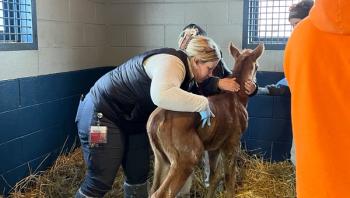
Top 10 reasons it's hard to be a veterinary technician
What is it about being a veterinary technician that makes the job so hard? Consider this list of challenges technicians face.
What is it about being a veterinary technician that makes the job so hard? Read my list of top 10 challenges on the next pages. Then share your own challenges at dvm360.com/community.
Photos: Getty Images
10. Euthanasia. Let’s just get this one out of the way. Euthanasia is hard. Is it the hardest part of our job? Nope, not nearly. What non-veterinary people may not understand is that more often than not, euthanasia is a gift we give to an ailing patient. Relieving pain and suffering is our calling, and there is some comfort in watching a struggling old patient stop struggling and be at peace. That having been said, comforting the humans is hard, because we know exactly how they feel, and it hurts. More than one veterinary technician graduate has dropped out of the profession after having to put down their own pet. Being reminded of that pain day after day is simply too hard for most people.
9. Pain. Pain is a part of life, right? That’s easy enough to say, but watching a helpless animal be in pain is a whole new ball game. Bad enough are the pets who quietly hide their suffering. But the cases that really tear at your heart are the pets who know they hurt, but don’t understand why. They’re scared, and there’s nothing you can do to explain it to them. And there’s always some small part of you that thinks the animal is blaming you for their pain, even though it’s not really your fault they got sick.
8. Fear. Every day, animals come into this office scared for their lives. They have no concept of what a hospital is, or that we’re here to help. The sounds are strange, the people are strange, the smells are strange, and people are touching, lifting, poking, prodding. Until you’ve worked on a pet yourself, you don’t really understand what it means to have to do painful things to an animal for their own good, and have them look at you with those fearful eyes. They really do think you’re trying to kill them, and it’s heartbreaking.
7. Bites and scratches. They don’t usually hurt physically nearly as much as the pain you feel inside your heart, knowing you got scratched or bitten by an animal you love and were just trying to help. It’s the flip side of No. 8.
6. Muss and fuss. It takes a special kind of crazy to devote yourself to animals—these goofy, furry, noisy, messy critters we love so much. It’s hard for a veterinary professional to understand why someone wouldn’t want fur all over their house. How could you not love taking your puppy out every two hours to potty train it? To veterinary technicians, cleaning up a sick pet’s mess makes them feel more sorry for the pet then for themselves for having to clean it up. That’s a special kind of love right there.
5. Breeders. There are two kinds of breeders; some breeders go through the pain, agony, and expense of breeding dogs because of their undying devotion to, and love of, a particular breed. These angels have devoted entire lifetimes to creating and molding hundreds of breeds of wonderful, functional, loving, sound, well-built, exquisitely diverse dog and cat pets and working animals for hundreds of years, and they have brought joy to my profession. They know it’s expensive, and difficult, and rarely profitable, but they do it anyway. And then there are the breeders who do it for money, those who have a special place reserved in the fourth circle of hell for their greed. It’s tough for a veterinary technician who knows the shelter is full of unwanted pets to smile at breeders and not hurt them. Luckily, the public is becoming wise to their puppy-milling ways, and rescue, foster, and adoption are becoming more and more common. Don’t shop, adopt!
4. Patience. Now, we’re starting to get into what’s really difficult about the veterinary profession. Coming up with a treatment plan that looks good on paper is easy. Performing those treatments on your pet, often when they’re in pain or not feeling so hot, is tough. Messy and difficult treatments are what separate the pet owning wheat from the chaff. So veterinary technicians are often put in the middle, guiding and encouraging pet owners to follow through with treatments. Often, the pet owners have other commitments, and they’re forced to do silly things like go to work and raise children instead of taking care of their pet all day and night. I’m kidding, of course.
But in all seriousness, when a pet comes into our office over and over again with a repeat problem that could maybe have been prevented with some time and effort at home, it’s frustrating. Frustrating for the pet owner and frustrating for the staff. Dealing with that mutual frustration on a daily basis and keeping everybody on task and focused on the pet’s best interests without placing blame takes a special kind of patience that only the most dedicated veterinary technicians are born with.
3. Understanding. Some people still think all pit bulls are just naturally mean,. That all Golden retrievers make good family pets. That bad dogs always come from abusive homes; so any puppy that comes from a loving home will automatically train itself to be a good family pet. That Chihuahuas are supposed to live in hand bags. That male cats are better, that female cats are better. Oy vey! These biases are very prevalent in our society, and by and large, they’re all wrong. Every day we see clients who are convinced their pet will be one thing and it becomes another. About 90 percent of what a veterinary technician does all day long is share the vast knowledge prior generations of veterinarians and veterinary technicians have learned in the school of hard knocks so owners don’t have to make the same mistakes of their predecessors. If teaching doesn’t bring a technician joy, having the same conversations day after day can lead to burnout. Every day technicians are faced with people who have been given incorrect information by someone else. And technicians must persist on behalf of the animal, sharing knowledge with patience and understanding, to correct that knowledge. Veterinary technicians are truly the most patient, understanding, caring people you will ever meet.
2. Persistence. To further the challenges we spoke about in No. 3, teaching clients who don’t know something but are willing to learn is hard, but it’s incredibly rewarding. What’s infinitely more difficult and soul crushing, though, is a case where the owner starts to wonder if the pet is worth the bother: frustrating, dragging cases where the client just wants Fido to “get better,” or if its a behavioral problem, to … well, to quit doing normal cat or dog things that normal cats and dogs do, and quit causing trouble. Loving animals means accepting their flaws and limitations, in sickness and in health, it’s not all puppies and kittens and purrs and wags. We know every day is not full of hugs and puppy breath. Turns out talking to people is what we do all day, often when they’re worried about their furry family member and conversations are difficult.
1. Overworked, underappreciated, and underpaid. This pretty much summarizes the entire veterinary technical profession. It’s not because we veterinarians are cheap either, but because the entirety of veterinary medicine is underfunded. That’s what happens when your profession has no medical insurance coverage, no government assistance, no public funding whatsoever, and every dollar that comes into this building has to come directly out of an owner’s pocket. Sadly, that chronic lack of cash flow trickles down and keeps vet technicians working for barely higher than minimum wage. Being a veterinary technician is a career of choice, a career of passion, hard work and sacrifice, but I can assure you, nobody is in it for the money.
So essentially, veterinary technicians are patient, understanding angels who are also good at persuading people to do things when either they or their pet would rather not, and they get paid peanuts to do it.
Newsletter
From exam room tips to practice management insights, get trusted veterinary news delivered straight to your inbox—subscribe to dvm360.






